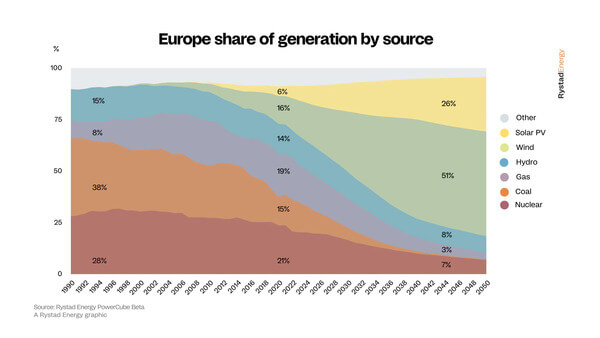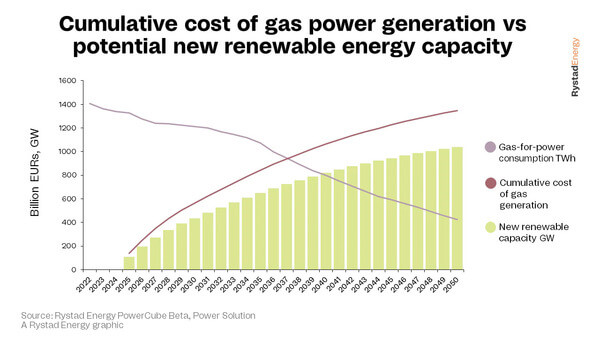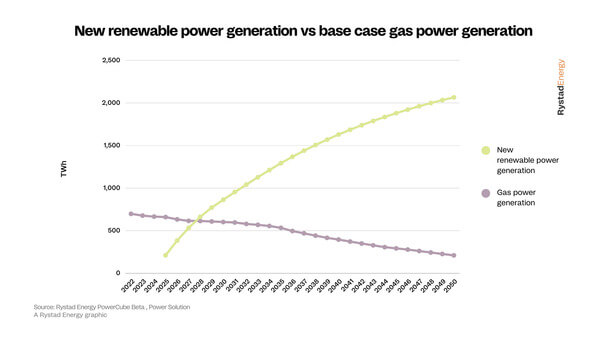News Release from Rystad Energy
Wind Industry Profile of
Energy crisis: the beginning of the end for gas-fired power in Europe
Rystad Energy research shows that with recent gas prices, it would be 10 times more expensive to operate gas-fired power plants in the long-term than to build new solar PV capacity in Europe. While gas prices are not expected to remain at such high levels in the medium-to-long-term, when and if they fall, gas will struggle to remain competitive in Europe’s power mix. This research uses the levelized cost of energy (LCOE) for gas and coal-fired power generation at different price levels and compares it to the LCOE of solar PV and wind.
European gas prices have hit exceptional highs this year as a drop in Russian gas exports has lifted the cost of power generation. Spot prices on the Netherlands-based Title Transfer Facility (TTF) gas hub, the main reference for Western Europe, have risen from an average of €46 per megawatt-hour (MWh) in 2021 to €134 per MWh so far this year – an increase of 187%. The price reached an historical peak of €330 per MWh in August, pushing the cost of generating electricity from gas close to €700 per MWh. Despite the increase in price, gas-fired generation output increased 4% during the first seven months of 2022, mainly due to a 100-terawatt-hour (TWh) drop in output from hydroelectric and nuclear generation.
The situation is unlikely to improve over Europe’s upcoming winter. As a result, Rystad Energy expects gas-fired generation will be needed to keep the lights on, despite the high cost of gas. For 2023, the return of nuclear generation plants and more renewable energy capacity should gradually reduce the need for gas-fired power. More than 50 gigawatts (GW) of new solar and wind capacity are planned to be commissioned next year, with French generator EDF hoping to bring back online up to 30 GW of nuclear capacity that is currently undergoing maintenance.
Rystad Energy forecasts that TTF prices will stabilize at around €31 per MWh by 2030, which puts the LCOE of existing plants closer to €150 per MWh. This is still three times more than the LCOE of new solar PV facilities. For gas-fired plants to continue being competitive, gas prices would need to fall closer to €17 per MWh and carbon prices would need to fall to €10 per tonne, which is currently unthinkable.
“European decision-makers need to decide between continuing to use expensive, less secure gas or investing in cheaper renewables and storage options. Gas will continue to play an important role in the European energy mix for some time to come, but unless something fundamental shifts, then simple economics, as well as climate concerns, will tip the balance in favor of renewables,” says Carlos Torres Diaz, head of power at Rystad Energy.

Gas versus alternatives: scenarios to 2025 and 2028
More than 100 GW of new renewable energy capacity could be developed in 2025 if funds needed for gas-fired power generation were instead used for this purpose. This estimate assumes a weighted average capital cost of solar PV and onshore wind technologies of €1.3 per Watt and that a couple of years would be needed to kick off the development.
By 2028, new renewable generation capacity installed using money that would otherwise have been spent on gas generation would reach 333 GW, which would be enough to generate 663 TWh of electricity. Renewable power generation would be enough to replace forecast gas-fired generation by this year. By 2050, new renewable energy capacity would be generating more than 2,000 TWh. This growth in generation only considers output from new capacity developed using ‘funds from gas’ and is on top of Rystad Energy’s base case forecast, which anticipates that 2,385 GW of solar PV and wind capacity, and 520 GW of utility scale batteries are installed by 2050.

High prices to hit long-term outlook for gas power
Shifting away from gas-fired power generation has proven to be more difficult than expected, but the high costs incurred in the recent period have led European countries to accelerate the development of renewable generation capacity. The short-term outlook for European gas prices is not optimistic as it will take some time for the market to adjust to a new reality without Russian gas. For Europe’s utilities and member states, at prices over €100 per MWh it is unsustainable to continue generating electricity using gas, especially when solar PV and onshore wind offer far cheaper alternatives.
In Rystad Energy’s base case scenario, gas-fired generation is expected to continue playing an important role in the European power mix. In the short-term, this source of electricity is vital to help meet demand. In the long-term, gas-fired generation capacity will continue to be needed to back up the intermittency of renewables, especially during winter when utility scale battery storage capacity cannot serve this purpose. The lower utilization of gas plants means that utilities will need to receive capacity payments to incentivize companies to keep their plants operational. However, given the large cost that gas represents and the very uncertain future over supplies, it makes sense for power companies to rethink their strategies and fast-track the development of renewable energy and storage capacity. While the European Commission is paving the way to achieve this with new energy security policies, the economic aspect could help speed things up. When it comes to renewables, the time is right to explore ways of avoiding supply chain bottlenecks and securing support from financial institutions.

- Source:
- Rystad Energy
- Author:
- Press Office
- Link:
- www.rystadenergy.com/...
- Keywords:
- Rystad Energy, Europe, gas, power, energy, solar, wind, renewables, end, energy transition, energy crisis, threat, price, market, challenge


























